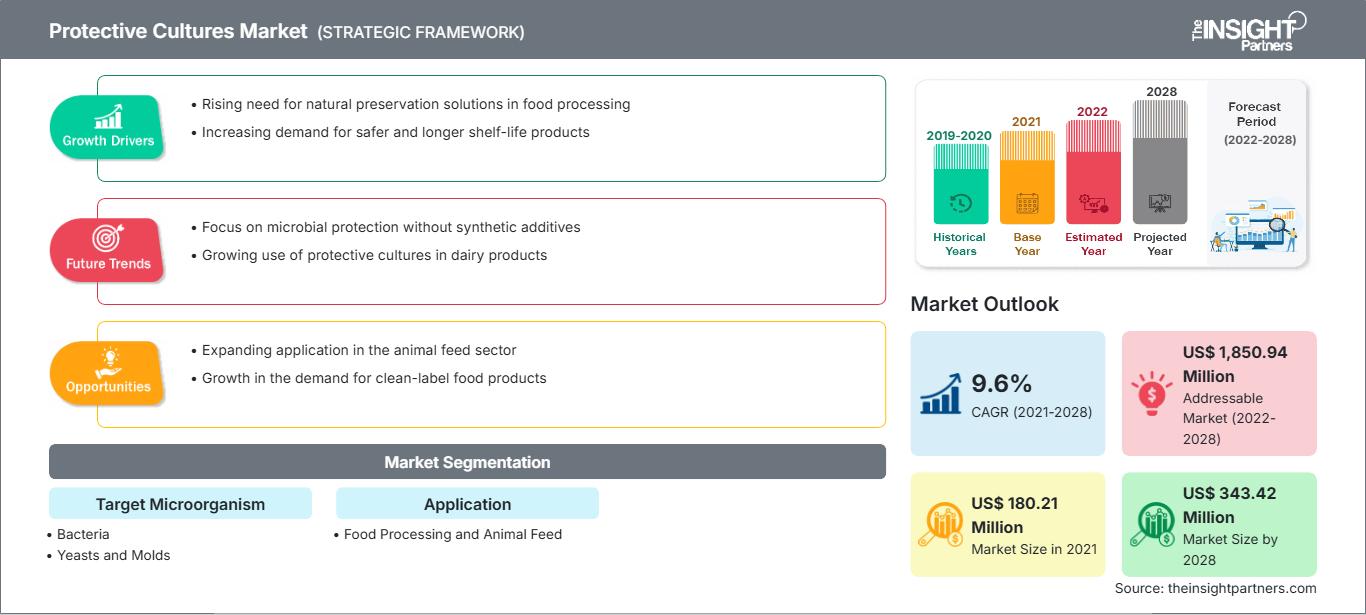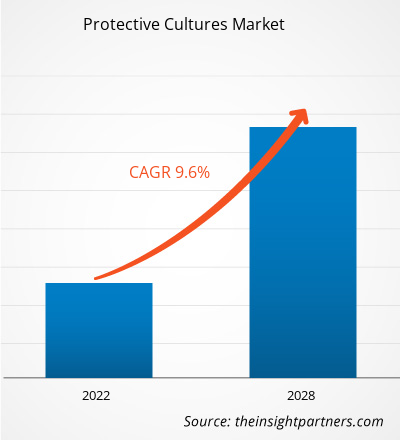[調査レポート]保護培養市場は、2021年の1億8,021万米ドルから2028年には3億4,342万米ドルに成長すると予想されており、2021年から2028年にかけて9.6%のCAGRで成長すると予測されています。
天然および化学保存料不使用製品の需要増加と、賞味期限の長い生鮮食品の需要増加が世界中で保護培養市場の成長を牽引しています。
アジア太平洋地域の保護培養市場は、予測期間中に最も高いCAGRで成長すると予想されています。中国は最も重要な乳製品市場であり、主に乳製品の消費量の増加によって牽引されています。ナチュラルスナック、サワーミルクなどの発酵乳製品、ヨーグルトなどの乳製品の需要増加と製品およびパッケージの革新が、アジア太平洋地域の乳製品市場の成長を牽引しています。そのため、乳製品の消費量の増加と、病原菌や腐敗菌の増殖を抑制するといった保護培養菌のメリットにより、保護培養菌市場は今後数年間で大幅な成長を遂げると予想されています。さらに、アジア人の間でナチュラルラベルやクリーンラベル製品に対する意識が高まっていることも、市場拡大を後押ししています。
要件に合わせてレポートをカスタマイズ
レポートの一部、国レベルの分析、Excelデータパックなどを含め、スタートアップ&大学向けに特別オファーや割引もご利用いただけます(無償)
保護培養市場: 戦略的洞察

-
このレポートの主要な市場動向を入手してください。この無料サンプルには、市場動向から見積もりや予測に至るまでのデータ分析が含まれます。
保護培養市場へのCOVID-19パンデミックの影響
現在も続くCOVID-19パンデミックは、保護培養市場に比較的プラスの影響を与えています。このパンデミックは、微生物培養に関連する関心と認識を高めるのに役立ちました。この危機は、世界中のほとんどの人々にとって不快でストレスの多い時期でした。そのため、世界中の人々がクリーンラベル製品を消費し始めました。COVID-19パンデミックの出現後、人々は食品に関してより慎重になり、通常の食事よりも健康的な食品を消費しています。COVID-19パンデミックは、ラベルや製品を超えたクリーンに対する消費者の認識を変えました。消費者は、家庭内および家庭外での購入におけるクリーンラベルへの注目を維持し続けており、さまざまな食品用途におけるクリーンラベルの適用が増加しています。さらに、2021年の経済成長の見通しは、ほとんどの国で楽観的です。
市場インサイト
乳製品の消費量の増加
乳製品市場は世界中で進化しています。消費者は、健康に良く、自然で、持続可能な乳製品を好み、原材料リストが短く、製品ラベルの透明性が高くなっています。現代の多忙なライフスタイルが増えるにつれて、鮮度を保つために冷蔵する必要がなく、外出先でも消費できる便利な選択肢の需要が高まっています。保護培養は、賞味期限全体にわたって腐敗を防ぐことで乳製品メーカーの収益を向上させる上で重要であり、自然でクリーンなラベルの製品に対する消費者のニーズに応えます。さらに、ヨーグルト、バター、チーズなどの乳製品の消費量は世界中で急増しています。
チーズは、世界中で毎日の食生活の主要な構成要素となっています。米国農務省によると、2017年には米国で5,733トンのチーズが生産され、北米の人々は平均して年間約6,626トンのチーズを消費しています。チーズ市場は、リステリア菌に対する特定の保護培養物の使用により、保護培養物の主要なエンドユーザーの一つでもあります。この保護培養物はラクトバチルス・プランタラムから作られ、リスクの高い赤いスメア表面熟成チーズにおけるリステリア菌の発生を防ぐのに効果的です。今後、前述の要因が保護培養物市場におけるチーズの需要を押し上げます。さらに、デュポン・ダニスコやChr Hansenなどの企業は、広範な乳製品保護培養物を用いて乳製品市場で大きな存在感を示しています。ナチュラルで健康的な乳製品の需要が高まる中、クリーンラベルおよびグリーンラベル製品は乳製品業界で大きな需要が見られています。
ターゲット微生物の洞察
ターゲット微生物に基づいて、保護培養市場は細菌と酵母およびカビに分かれています。酵母とカビのセグメントは、2020年に大きな市場シェアを占めました。酵母は真菌のサブセットであり、カビやキノコも含まれる大きな生物群です。酵母は通常、特殊な環境で生息できるように進化した単細胞生物です。酵母は通常、ピクルス、メープルシロップなどの高塩分または高糖分の食品に定着し、それらの劣化に寄与します。低pHの果物や液体もターゲットであり、肉やチーズの表面で発生する酵母もあります。カビは、数百万個の微小な細胞が連鎖状につながって形成されており、パン、果物、湿った紙などの表面に生息しています。乾燥食品、塩漬けの魚、果物、ゼリー、パン、漬物、ジャムなどの製品を腐らせる可能性があります。
用途別洞察
用途別に見ると、保護培養物市場は食品加工と動物飼料に分かれています。2020年には食品加工分野が大きな市場シェアを占めましたが、予測期間中は動物飼料分野がより高いCAGRを記録すると予想されています。食品加工は、乳製品、飲料、肉、鶏肉、魚介類製品など、さまざまな産業で構成されています。保護培養物は、一般的に食用に安全(GRAS)と認められており、多くの食品の微生物叢に自然に多く含まれているため、特に乳製品、肉、魚介類の業界では、保護培養物の使用が増加しています。また、より長い賞味期限を持つ製品のニーズにより、食品加工業者は保護培養物を使用するケースが増えています。さらに、消費者は、腐敗やカビの繁殖により大量の食品廃棄物が発生することに気づき始めています。これは食品加工業者の収益性にも影響するため、加工業者は食品廃棄物を削減するために保護培養物を使用しています。したがって、食品業界ではこれらの製品の需要が高まっています。保護培養物は、乳製品生産者が賞味期限全体にわたって腐敗を防ぎ、賞味期限を延ばしながら自然でよりクリーンな製品を求める消費者のニーズを満たすことで製品の品質を向上させる上で非常に重要です。
保護培養物市場で事業を展開している企業としては、Biochem Srl、Bioprox、Chr. Hansen Holding A/S、Meat Cracks Technologie GmbH、DSM、Lallemand Inc.、International Flavors &フレグランス社、ケリーグループ、サッコシステム、ダルトンバイオテクノロジーズ社。主要企業は合併や買収、研究開発などの戦略を採用して顧客基盤を拡大し、世界市場で大きなシェアを獲得し、世界的にブランド名を維持することも可能にしています。
保護培養市場の地域別分析
予測期間を通じて保護培養市場に影響を与える地域的な傾向と要因については、The Insight Partnersのアナリストが詳細に説明しています。このセクションでは、北米、ヨーロッパ、アジア太平洋、中東・アフリカ、中南米における保護培養市場のセグメントと地域についても説明します。
保護培養市場レポートの範囲
| レポート属性 | 詳細 |
|---|---|
| の市場規模 2021 | US$ 180.21 Million |
| 市場規模別 2028 | US$ 343.42 Million |
| 世界的なCAGR (2021 - 2028) | 9.6% |
| 過去データ | 2019-2020 |
| 予測期間 | 2022-2028 |
| 対象セグメント |
By 対象微生物
|
| 対象地域と国 |
北米
|
| 市場リーダーと主要企業の概要 |
|
保護文化市場のプレーヤー密度:ビジネスダイナミクスへの影響を理解する
保護培養市場は、消費者の嗜好の変化、技術の進歩、製品の利点に対する認知度の高まりといった要因によるエンドユーザーの需要増加に牽引され、急速に成長しています。需要の増加に伴い、企業は製品ラインナップの拡充、消費者ニーズへの対応のための革新、そして新たなトレンドの活用を進めており、これが市場の成長をさらに加速させています。

- 入手 保護培養市場 主要プレーヤーの概要
レポートの注目点
- 保護培養市場における進歩的な業界動向。プレーヤーが効果的な長期戦略を策定するのに役立ちます
- 先進国と発展途上国で採用されているビジネス成長戦略
- 2019年から2028年までの保護培養市場の定量分析
- 保護培養の世界的需要の推定
- ポーターのファイブフォース分析
- 競争の激しい市場シナリオを理解するための最近の動向
- 保護培養市場の成長を促進および抑制する要因、市場動向と展望
- 商業的関心を支え、市場の成長につながる市場戦略を強調することにより、意思決定プロセスを支援
- さまざまなノードにおける保護培養市場の規模
- 市場の詳細な概要とセグメンテーション、および保護培養業界のダイナミクス
- 有望な成長機会のあるさまざまな地域の保護培養市場の規模
保護培養市場 – 対象微生物別
- 細菌
- 酵母とカビ
保護培養市場 – 用途別
- 食品加工
- 乳製品
- 飲料
- 肉、鶏肉、およびシーフード製品
- その他
- 動物飼料
企業プロファイル
- Biochem Srl
- Bioprox
- Chr. Hansen Holding A/S
- Meat Cracks Technologie GmbH
- DSM
- Lallemand Inc.
- International Flavors & Ltd. Fragrances Inc.
- Kerry Group
- Sacco System
- Dalton Biotechnologies Srl
- 過去2年間の分析、基準年、CAGRによる予測(7年間)
- PEST分析とSWOT分析
- 市場規模価値/数量 - 世界、地域、国
- 業界と競争環境
- Excel データセット
最新レポート
お客様の声
購入理由
- 情報に基づいた意思決定
- 市場動向の理解
- 競合分析
- 顧客インサイト
- 市場予測
- リスク軽減
- 戦略計画
- 投資の正当性
- 新興市場の特定
- マーケティング戦略の強化
- 業務効率の向上
- 規制動向への対応






















 無料サンプルを入手 - 保護培養市場
無料サンプルを入手 - 保護培養市場